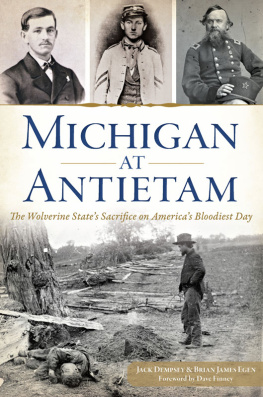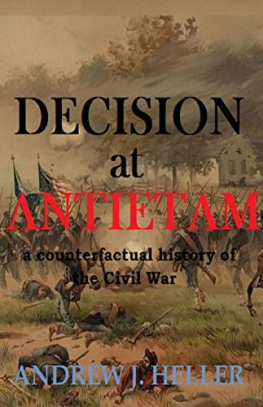

Published by The History Press
Charleston, SC 29403
www.historypress.net
Copyright 2015 by Jack Dempsey and Brian James Egen
All rights reserved
First published 2015
e-book edition 2015
ISBN 978.1.62585.456.8
Library of Congress Control Number: 2015943860
print edition ISBN 978.1.62619.927.9
Notice: The information in this book is true and complete to the best of our knowledge. It is offered without guarantee on the part of the authors or The History Press. The authors and The History Press disclaim all liability in connection with the use of this book.
All rights reserved. No part of this book may be reproduced or transmitted in any form whatsoever without prior written permission from the publisher except in the case of brief quotations embodied in critical articles and reviews.
To my wife, Jody, and daughter, Scarlettthe two loves of my life.
Brian
To those who sacrifice for love of our country.
Jack
CONTENTS
FOREWORD
It is almost implausible to recognize that Michigans role in the iconic September 1862 Antietam Campaign has never been chronicled in a book format. To fill this void, historians Jack Dempsey and Brian Egen have exhaustively researched the contributions of Michigan commanders and regiments that participated in the epic struggle in Maryland. Now, for the first time, their findings are brought together in this volume, which provides a valuable historical record of Michigans significant participation in the Antietam Campaign. Dempsey and Egens superior scholarship, research and analysis provide new insights and facts that will illuminate the record of Michigan Wolverines in this pivotal Civil War struggle.
Historians agree that in early September 1862, Confederate morale was at a peak, and a victory in Northern territory might well have guaranteed Southern independence. Since the spring of 1862, General Robert E. Lees Army of Northern Virginia had achieved unprecedented success against Union forces. Lee was triumphant in the Seven Days Battles and at Cedar Mountain, Second Bull Run and Chantilly. Based on this string of stunning victories, Lee embarked on an invasion of Maryland that would culminate along the banks of Antietam Creek on September 17, 1862, in the bloodiest day in American history.
Lees goals were to carry the war north of the Potomac River and encourage Maryland to join the Confederacy. Additionally, it was an opportunity to recruit Marylanders, replenish food supplies, obtain clothing for the army and destroy vital lines of communication by targeting railroads, canals and bridges. It was also believed that a major victory north of the Potomac River would influence England and France to recognize the Confederacy.
Michigan regiments that participated in the Antietam Campaign included the 1st, 4th, 7th, 8th, 16th, 17th and Bradys company of sharpshooters, which was attached to the 16th Michigan infantry regiment. Captain Melvin Brewers Company L, 1st Michigan Cavalry, served as escort for Generals Joseph Mansfield and Alpheus S. Williams during the campaign. Michiganders shed their blood in the fight at South Mountain, on the horrific blood-soaked fields of Sharpsburg and during the final action at Shepherdstown. The 17th Michigan attained fame for its bravery at South Mountain and was known as the Stonewall regiment for the duration of the war. The 7th Michigan suffered severely in the battle near the West Woods just north of the Dunker Church.
Following the Battle of Antietam, the character of the war changed. The battle may not have been a turning point militarily, but it certainly was politically, and it altered Lincolns primary goal of saving the Union, modifying it to include the moral component of ending slavery. On September 22, 1862, President Lincoln issued the preliminary form of the Emancipation Proclamation.
No doubt exists regarding the fact that Michigan soldiers fought gallantly and shed their blood at South Mountain; the North, East and West Woods; in the Miller Cornfield; around the Dunker Church; in the Sunken Road; and at Burnsides Bridge. Yet no monument has been erected that reflects the sacred sacrifice of Michigan troops on the slopes of South Mountain, the undulating and rolling fields around Sharpsburg or along the banks of Antietam Creek. A monument recognizing all Michiganders who fought in this military campaign is long overdue but so appropriate regardless of timing. The authors are graciously and generously donating the royalties from this publication toward the creation of a Michigan monument at Antietam. Land adjacent to the old Hagerstown Turnpike has already been acquired and the necessary 501(c)(3) status obtained from the Internal Revenue Service. By purchasing this book, you are contributing to the creation of a Michigan monument at Antietam. I hope you agree that this is our time to honor and recognize those Michigan boys in blue who fought at Antietam to preserve the Union and end the institution of slavery.
DAVID D. FINNEY JR.
Teacher, Historian, Author
Historical Consultant on Antietam: A Documentary Film
PREFACE
Wednesday, September 17, 1862, was the single bloodiest day in our nations history. From sunup to sundown, the Battle of Antietam cost approximately 23,110 lives either killed, wounded, missing or taken as prisoners of warnearly 2 Americans every second during the course of the battle. The bloodletting came in only the second calendar year of the conflict, shocking all Americans and transforming their understanding of the war.
The Antietam battlefield was extensively photographed just days after the armies clashed. For the first time, the carnage of war was visually brought to the doorsteps of Americans through newspaper illustrations, reproduced images and gallery exhibitions. Mangled and bloated bodies, devastated farms, burned houses and ruined property brought home the incredible sacrifice and suffering of the combatants and civilian population of a rural section of Maryland. Among those graphic images was the hastily dug grave of a young lieutenant from Monroe, Michigan, where he fell on the field of battle.
According to one of the preeminent battle historians, no battle of the Civil Warnot Gettysburg, not Vicksburg, not Missionary Ridgewas in the end more meaningful than Antietam.
The battle also yielded another outcome. Days after, Abraham Lincoln signed the preliminary Emancipation Proclamation. The War for the Union had also become a war for human freedom.
Because of its location in rural Maryland, the battlefield of Antietam remains intact, largely undisturbed by development. From the National Park Service visitors center one can survey much of the hallowed land, gaze out toward the high ground on South Mountain and conjure images of the fateful day when Americans viciously fought one another.
To aid remembrance, a number of states and others interested in patriotism have memorialized the sacrifices of the men who fought here. More than one hundred monuments are arrayed across the landscape. Signposts describe units and actions. Some landmarks of the terrible day, such as the Dunker Church, Burnsides Bridge and Bloody Lanea dirt farm lane known to locals before the battle as the Sunken Roadhave become iconic in Civil War literature and consciousness.
Despite the fact that Antietam was the single bloodiest day in American history, Michigan has no monument honoring its sacrifice. For reasons not readily apparent, no unit is commemorated by statue or stone. The sacrifice of one officer is commemorated by an inverted cannon, but his story is difficult to discover. The role that Michiganders played in this pivotal contest has, in the succeeding 150 years, receded into the fog of war. Whether because other battlefields such as Gettysburg and Chickamauga drew the attention and resources for monuments at Antietam or due to the veterans feelings toward the carnage and savagery of this battle, we may never know the reasons.
Next page










